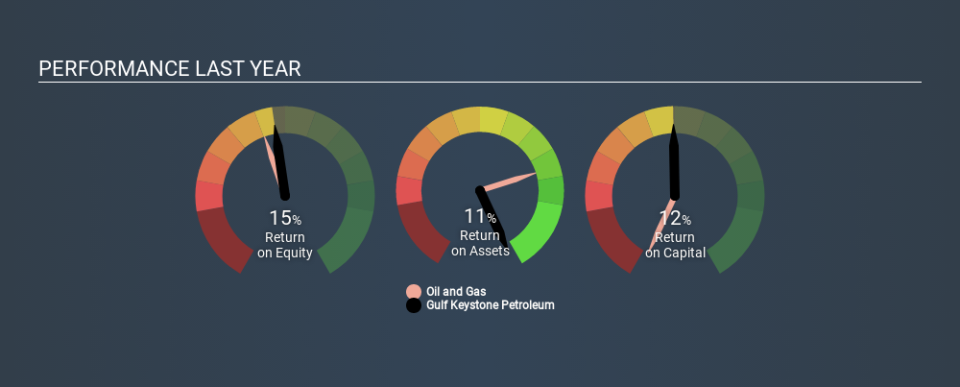Gulf Keystone Petroleum Limited (LON:GKP) Is Employing Capital Very Effectively

Today we'll evaluate Gulf Keystone Petroleum Limited (LON:GKP) to determine whether it could have potential as an investment idea. To be precise, we'll consider its Return On Capital Employed (ROCE), as that will inform our view of the quality of the business.
First, we'll go over how we calculate ROCE. Next, we'll compare it to others in its industry. Last but not least, we'll look at what impact its current liabilities have on its ROCE.
What is Return On Capital Employed (ROCE)?
ROCE is a metric for evaluating how much pre-tax income (in percentage terms) a company earns on the capital invested in its business. In general, businesses with a higher ROCE are usually better quality. In brief, it is a useful tool, but it is not without drawbacks. Renowned investment researcher Michael Mauboussin has suggested that a high ROCE can indicate that 'one dollar invested in the company generates value of more than one dollar'.
How Do You Calculate Return On Capital Employed?
Analysts use this formula to calculate return on capital employed:
Return on Capital Employed = Earnings Before Interest and Tax (EBIT) ÷ (Total Assets - Current Liabilities)
Or for Gulf Keystone Petroleum:
0.12 = US$77m ÷ (US$773m - US$123m) (Based on the trailing twelve months to June 2019.)
So, Gulf Keystone Petroleum has an ROCE of 12%.
See our latest analysis for Gulf Keystone Petroleum
Does Gulf Keystone Petroleum Have A Good ROCE?
ROCE is commonly used for comparing the performance of similar businesses. Using our data, we find that Gulf Keystone Petroleum's ROCE is meaningfully better than the 9.8% average in the Oil and Gas industry. We consider this a positive sign, because it suggests it uses capital more efficiently than similar companies. Independently of how Gulf Keystone Petroleum compares to its industry, its ROCE in absolute terms appears decent, and the company may be worthy of closer investigation.
Gulf Keystone Petroleum reported an ROCE of 12% -- better than 3 years ago, when the company didn't make a profit. That suggests the business has returned to profitability. You can click on the image below to see (in greater detail) how Gulf Keystone Petroleum's past growth compares to other companies.
Remember that this metric is backwards looking - it shows what has happened in the past, and does not accurately predict the future. Companies in cyclical industries can be difficult to understand using ROCE, as returns typically look high during boom times, and low during busts. This is because ROCE only looks at one year, instead of considering returns across a whole cycle. Remember that most companies like Gulf Keystone Petroleum are cyclical businesses. Future performance is what matters, and you can see analyst predictions in our free report on analyst forecasts for the company.
Gulf Keystone Petroleum's Current Liabilities And Their Impact On Its ROCE
Current liabilities include invoices, such as supplier payments, short-term debt, or a tax bill, that need to be paid within 12 months. The ROCE equation subtracts current liabilities from capital employed, so a company with a lot of current liabilities appears to have less capital employed, and a higher ROCE than otherwise. To counter this, investors can check if a company has high current liabilities relative to total assets.
Gulf Keystone Petroleum has total assets of US$773m and current liabilities of US$123m. As a result, its current liabilities are equal to approximately 16% of its total assets. A fairly low level of current liabilities is not influencing the ROCE too much.
What We Can Learn From Gulf Keystone Petroleum's ROCE
This is good to see, and with a sound ROCE, Gulf Keystone Petroleum could be worth a closer look. Gulf Keystone Petroleum shapes up well under this analysis, but it is far from the only business delivering excellent numbers . You might also want to check this free collection of companies delivering excellent earnings growth.
For those who like to find winning investments this free list of growing companies with recent insider purchasing, could be just the ticket.
If you spot an error that warrants correction, please contact the editor at editorial-team@simplywallst.com. This article by Simply Wall St is general in nature. It does not constitute a recommendation to buy or sell any stock, and does not take account of your objectives, or your financial situation. Simply Wall St has no position in the stocks mentioned.
We aim to bring you long-term focused research analysis driven by fundamental data. Note that our analysis may not factor in the latest price-sensitive company announcements or qualitative material. Thank you for reading.

 Yahoo Finance
Yahoo Finance 
